Scottish greenhouse gas emissions 2017
Estimates of greenhouse gas emissions in Scotland for the years 1990 to 2017.
This document is part of 2 collections
Section B. Results – Net Sources of Scottish Greenhouse Gas Emissions
2017 results
Chart B1 presents the sources and sinks of Scottish Greenhouse Gas Emissions in 2017, grouped by Scottish Government sector.
Chart B1. Sources of Scottish Greenhouse Gas Emissions, 2017. Values in MtCO2e
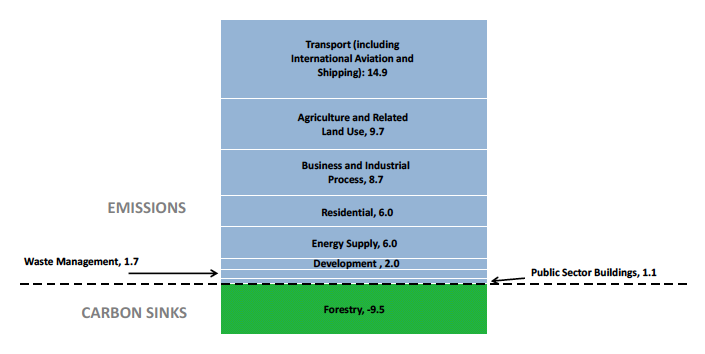
Main points
- In 2017, Transport (including International Aviation and Shipping) (14.9 MtCO2e) was the largest source of net emissions followed by Agriculture and Related Land Use (9.7 MtCO2e) and Business and Industrial Process (8.7 MtCO2e).
- Forestry was the only aggregate sector in which there has been a net emissions sink (-9.5 MtCO2e).
Table B1. Scottish Greenhouse Gas Emissions by Gas and by Scottish Government Source Sector, 2017. Values in MtCO2e
| Total | Percentage share by sector | Carbon dioxide | Methane | Nitrous oxide | Fluorinated gases | |
|---|---|---|---|---|---|---|
| Total | 40.5 | 100.0% | 29.6 | 6.4 | 3.2 | 1.3 |
| Transport (including International Aviation and Shipping) | 14.9 | 36.8% | 14.7 | 0.0 | 0.2 | 0.0 |
| Transport (excluding IA&S) | 13.0 | 32.1% | 12.9 | 0.0 | 0.1 | 0.0 |
| International Aviation and Shipping (IA&S) | 1.9 | 4.6% | 1.9 | 0.0 | 0.0 | 0.0 |
| Agriculture and Related Land Use | 9.7 | 23.9% | 2.8 | 4.3 | 2.6 | 0.0 |
| Business and Industrial Process | 8.7 | 21.4% | 7.4 | 0.0 | 0.1 | 1.2 |
| Residential | 6.0 | 14.9% | 5.8 | 0.1 | 0.0 | 0.1 |
| Energy Supply | 6.0 | 14.9% | 5.6 | 0.4 | 0.1 | 0.0 |
| Development | 2.0 | 4.9% | 1.8 | 0.0 | 0.1 | 0.0 |
| Waste Management | 1.7 | 4.2% | 0.0 | 1.6 | 0.1 | 0.0 |
| Public Sector Buildings | 1.1 | 2.7% | 1.1 | 0.0 | 0.0 | 0.0 |
| Forestry | -9.5 | -23.6% | -9.6 | 0.0 | 0.1 | 0.0 |
Main points
Carbon dioxide was the main greenhouse gas emitted or removed in most sectors, with the exceptions of the Agriculture and Related Land Use and Waste Management sectors.
- Methane was the main net gas emitted in the Agriculture and related Land Use sector (4.3 MtCO2e), followed by carbon dioxide (2.8 MtCO2e) and nitrous oxide (2.6 MtCO2e).
- Almost all emissions in the Waste Management sector were emitted in the form of methane (1.6 MtCO2e).
Where F gases are emitted, they have been in relatively small amounts via the Business and Industrial Process source sector, as well as in the Residential sector.
Key Trends By Scottish Government Source Sector
Chart B2 presents the main sources of Scottish Greenhouse Gas Emissions from 1990 to 2017, broken down by Scottish Government source sector. Note that for the purposes of presentation, some sectors have been grouped together on this chart. Chart B3 and Chart B4 specifically explore the trend in Energy Supply emissions. Chart B5 contains information on the absolute and percentage reductions in greenhouse gas emissions in every Scottish Government source sector over the entire time period, with Chart B6 containing the same information for the latest year.
Chart B2. Main Sources of Greenhouse Gas Emissions in Scotland, 1990 to 2017. Values in MtCO2e
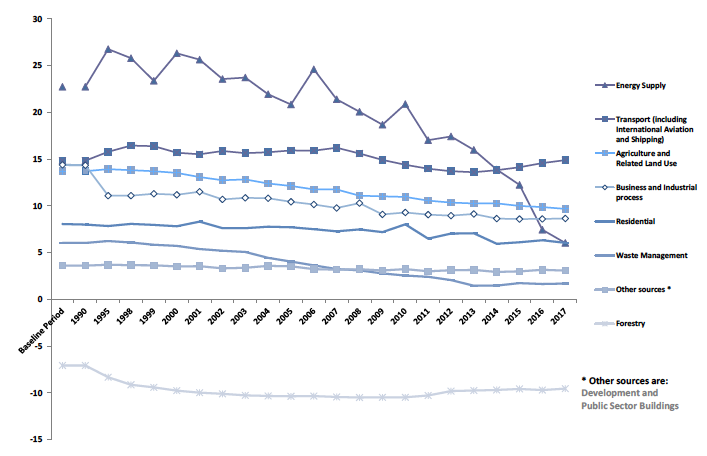
Main Points
Most sectors exhibit a general downwards trend between 1990 and 2017:
- Energy Supply emissions have seen the largest decrease in MtCO2e (-16.7 MtCO2e, a reduction of 73.5 per cent) followed by Business and Industrial Process (-5.7 MtCO2e, a reduction of 39.7 per cent), Waste Management (-4.3 MtCO2e, a reduction of 72.0 per cent) and Agriculture and related land use (-4.0 MtCO2e, a reduction of 29.4 per cent)
- International Shipping and Aviation emissions have increased (0.6 MtCO2e, a 43.4 per cent increase) along with Development emissions (0.1 MtCO2e, 4.4 per cent increase)
- The Forestry sink has increased (-2.5 MtCO2e absolute change, an increase of 34.9 per cent).
Chart B3 shows how the generation of Scotland's electricity has changed over time. Emissions from the electricity supply sector (such as power stations) are associated with these changes.
Chart B3. Generation of Electricity by Fuel, Scotland, 2000 to 2017. GWh of Electricity Generated by Year
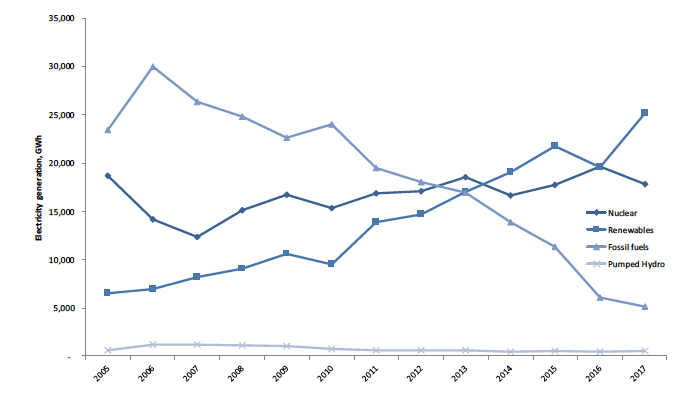
Data obtained from Scottish Energy Statistics Database[5]
Main Points
Renewables were the single largest source of electricity generated in Scotland in 2017 at 51.7 per cent, followed by nuclear generation at 36.6 per cent with fossil fuel generation making up only 10.5 per cent. Overall electricity generation in Scotland increased by 2,906 GWh to 48,678 GWh in 2017. Since 2000, Scotland has seen a decline in fossil fuel electricity generation and a substantial increase in generation from renewables.
Long term (1990 to 2017) and short term (2016 to 2017) trends by sector
Chart B4 shows how emissions have changed between 1990 and 2017 in all source sectors. Chart B5 shows how emissions have changed between 2016 and 2017.
Chart B4. Change in Net Emissions by Scottish Government Sector Between 1990 and 2017 – in MtCO2e, and percentage changes [6]
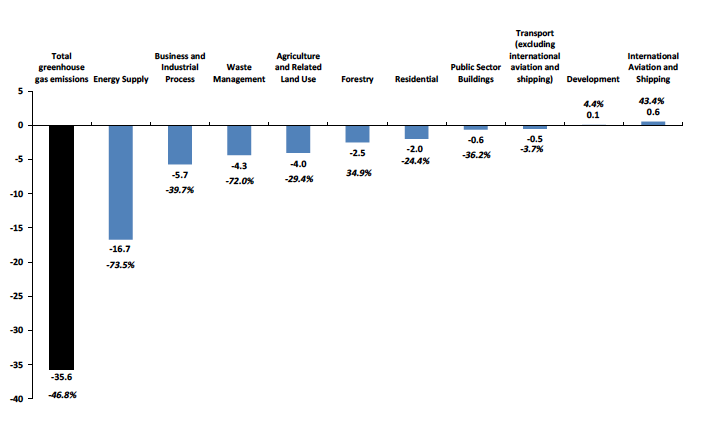
Chart B5. Change in Net Emissions by Scottish Government Sector between 2016 and 2017 - in MtCO2e, and percentage changes [7]
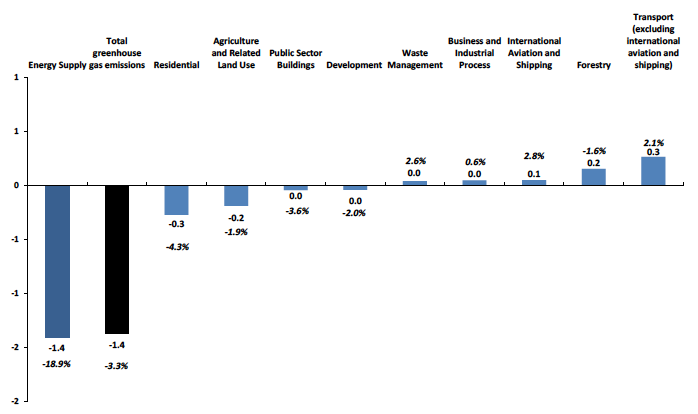
Total Emissions
Overall, there has been a 35.6 MtCO2e (46.8 per cent) decrease in net emissions between 1990 and 2017, and there has been a 1.4 MtCO2e (3.3 per cent) decrease in net emissions between 2016 and 2017.
Energy Supply (15 per cent of 2017 inventory)
Energy sector emissions have decreased by 18.9 per cent between 2016 and 2017, and have reduced by 73.5 per cent from 1990. Emissions reductions in this sector are mainly due to reductions in emissions from power stations and the complete cessation of coal use in electricity generation in Scotland.
Power station emissions have reduced by 92 per cent between 1990 and 2017, due primarily to the shift in fuel mix from coal to less carbon intensive fuels, including increased use of nuclear and renewables. The Energy Supply sector alone accounts for 38 per cent of the decline in Scotland emissions since the base year.
Residential (15 per cent of 2017 inventory)
Residential emissions have decreased between 2016 and 2017 from 6.3 MtCO2e to 6.0 MtCO2e (-4.3 per cent) and there has been a decrease of 24.4 per cent between 1990 and 2017. This long-term decrease is mainly due to a switch from less efficient solid and liquid fuels to natural gas for heating, and improvements in energy efficiency.
The main driver for the decrease in residential emissions between 2016 and 2017 is an decrease in the combustion of fuel in households, dominated by an decrease in natural gas use, possibly reflecting warmer mean temperatures in the start of 2017 compared to 2016 (Chart B6).
Chart B6. Mean air temperature by month, Scotland. 2016 and 2017. Values in °C
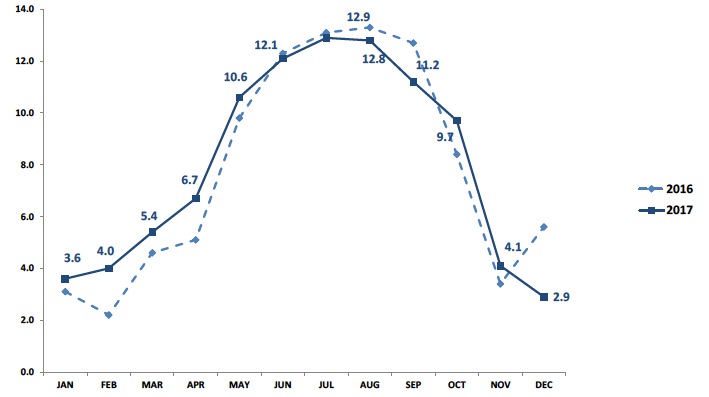
Data obtained from Met Office[8]
Waste Management (4 per cent of 2017 inventory)
From 2016 to 2017 emissions from waste management increased slightly from 1.6 MtCO2e to 1.7 MtCO2e. Between 1990 and 2017 emissions reduced by 72.0 per cent. This decrease is largely due to the progressive introduction of methane capture and oxidation systems within landfill management.
Business and Industrial Process (21 per cent of 2017 inventory)
This sector has seen a 5.7 MtCO2e (39.7 per cent) fall in emissions between 1990 and 2017. As shown in Chart B2, much of this decrease occurred between 1990 and 1995 – linked to a decline in emissions from manufacturing and the iron and steel industry over this time period. There has been a further smaller decrease between 2008 and 2009, coinciding with the recession. There was a marginal increase (less than 0.05 MtCO2e; 0.6 per cent) in emissions in this sector between 2016 and 2017.
Agriculture and Related Land Use (24 per cent of 2017 inventory)
This sector has seen a 4.0 MtCO2e (29.4 per cent) fall in net emissions between 1990 and 2017. Between 2016 and 2017, there was a 0.2 MtCO2e (1.9 per cent) decrease in net emissions of overall greenhouse gases from this sector.
Forestry (-24 per cent of the 2017 inventory)
Between 2016 and 2017, the forestry sink decreased by 1.6 per cent from -9.7 MtCO2e to -9.5 MtCO2e. Scotland was a net sink of greenhouse gases from Forestry activities from 1990-2017.
Transport Including International Aviation and Shipping (37 per cent of 2017 inventory)
Transport emissions have increased by 2.2 per cent between 2016 and 2017. Transport emissions increased by 0.4 per cent from 1990 to 2017. The increase in emissions in 2017 was mainly due to an increase in emissions from road transport.
In 2017, road transport was the largest source of emissions in Scotland. Road transport emissions have increased by 11.1 per cent between 1990 and 2017; this is due to a growth in activity over the period offset partly by improvements in the efficiency of vehicles.
International aviation has increased from 1.4 MtCO2e in 2016 to 1.5 MtCO2e in 2017. An increase of 6.8 per cent between 2016 and 2017. Emissions from international aviation from Scotland have increased by 181 per cent since 1990 due to greater demand.
Emissions from international shipping decreased slightly by 3.6 per cent between 2016 and 2017. Emissions from international shipping have declined since 1990 by 54.3 per cent.
Public Sector Buildings (3 per cent of the 2017 inventory)
The main source of emissions from this sector is the use of natural gas for heating public buildings. There was a 0.6 MtCO2e (36 per cent) fall in emissions from public sector buildings between 1990 and 2017. This has been largely driven by a reduction in the use of oil and coal for space heating. Between 2016 and 2017, there was a very slight decrease in emissions from this sector; a decrease of 3.6 per cent.
Development Emissions (5 per cent of 2017 inventory)
This sector captures net emissions from land surrounding settlements and from land converted to settlements; and shows an increase of 4.4 per cent between 1990 and 2017 although emissions in the latest year fell by 2.0 per cent.
Emissions by type of gas
Chart B7 shows the trends in emissions, broken down by gas from 1990 to 2017.
Chart B7. Scottish Greenhouse Gas Emissions, by Gas, 1990-2017. Values in MtCO2e
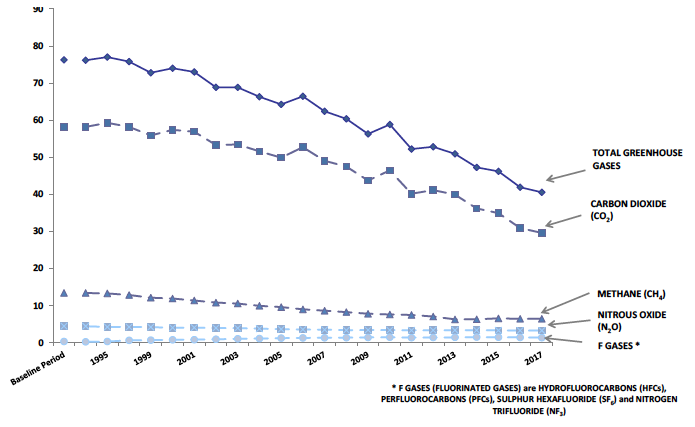
Main Points
- Carbon dioxide is by far the largest contributor to Scottish greenhouse gas emissions in all years (73.7 per cent of all emissions in 2017) and is the most volatile series of all gases – largely driven by changes in energy supply emissions and to a lesser extent, emissions from the residential and business and industrial process sectors.
- Methane is the second most common greenhouse gas in 2017 (15.3 per cent of all net emissions) followed by nitrous oxide (7.7 per cent) and F-Gases making up the remainder (3.3 per cent).
- Carbon dioxide has seen the largest reduction from 1990 to 2017 (-28.6 MtCO2e). There have also been reductions in both methane (7.0 MtCO2e) and nitrous oxide (1.2 MtCO2e). Emissions from fluorinated gases have shown a large increase from 1990 to 2017, although they still remain small in absolute terms, driven by the introduction of hydrofluourocarbons (HFCs) from 1995 onwards. These HFCs replace chlorofluorocarbons (CFCs) which were banned by the Montreal Protocol due to their impact on the ozone layer.
Charts B8 to B11 present results on individual gases broken down by main Scottish Government sectors over time. Chart B8 shows how carbon dioxide emissions have changed from 1990 to 2017.
Carbon Dioxide (CO2)
Chart B8. Carbon Dioxide (CO2) Emissions by Scottish Government Sector, 1990 to 2017. Values in MtCO2e
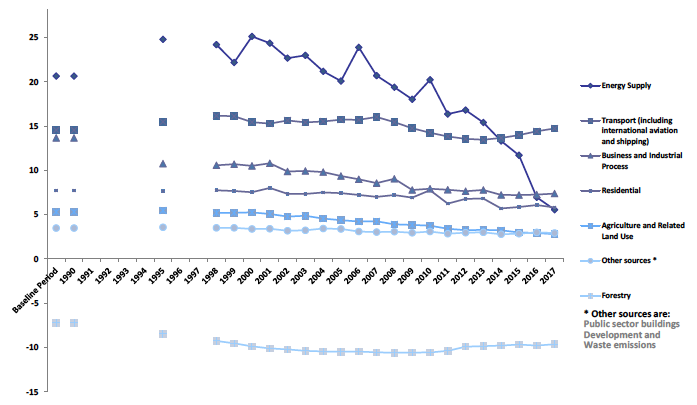
Main Points
- Chart B8 shows that Energy Supply is a key source of carbon dioxide emissions in all years between 1990 and 2015, after which the change in fuels used in electricity generation substantially reduces CO2 emissions from this source. Transport (including international aviation and shipping) is the next most common source of carbon dioxide emissions across the entire time-series. Transport is 9.2 MtCO2e higher than energy supply emissions in 2017. In 2013 Transport became the highest source of emissions for the first time in the time series.
- Much of the decrease in carbon dioxide emissions between 1990 and 2017 has been driven by reductions in energy supply emissions across the time period, particularly since 2015, and in business and industrial processes between 1990 and 1995. Carbon dioxide emissions from the energy supply sector have been volatile, with the highest emissions occurring between 1995 and 2003, and a spike in 2006, related to a greater use of coal in that year.
- The agriculture and related land use sector has also seen a reduction in net emissions of carbon dioxide – largely due to changes in the management of land, with lower emissions resulting from the conversion of grassland to cropland.
- Forestry has been a net sink of carbon dioxide consistently between 1990 and 2017.
Methane (CH4)
Chart B9. Methane (CH4) Emissions by Scottish Government Sector, 1990 to 2017. Values in MtCO2e
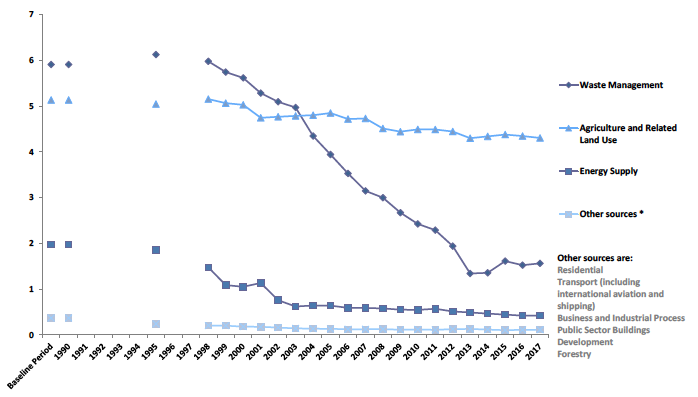
Main Points
- Methane emissions from waste management have fallen by 4.3 MtCO2e between 1990 and 2017 (a 73.6 per cent reduction). This is due to the progressive introduction of landfill gas being captured and used for energy. There could also be other factors which contribute to this reduction, such as improvements in the standards of landfill and changes to the types of waste going to landfill.
- Methane emissions in the agriculture and related land use sector have fallen by 0.8 MtCO2e between 1990 and 2017 – a 16.2 per cent fall over this time period. This reduction is partly linked to a fall in livestock numbers.
- In the Energy Supply sector, methane emissions have fallen by 1.6 MtCO2e between 1990 and 2017, largely due to reductions in emissions from sources such as coal mining.
Nitrous Oxide (N2O)
Chart B10. Nitrous Oxide (N2O) Emissions by Scottish Government Sector, 1990 to 2017. Values in MtCO2e
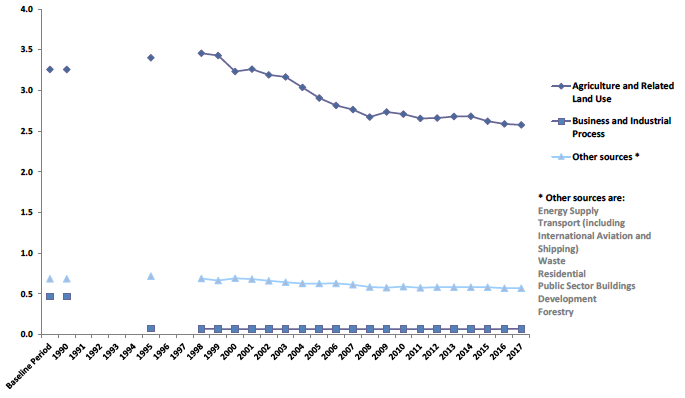
Main Points
- The Agriculture and related land use sector is by far the main contributor to emissions of nitrous oxide. These are largely produced by agricultural practices on soils, and to a lesser extent by animal manures. Emissions of nitrous oxide in this sector have fallen from 3.3 MtCO2e in 1990 to 2.6 MtCO2e in 2017.
- Emissions of nitrous oxide in the business and industrial process sector have fallen from 0.5 MtCO2e in 1990 to 0.1 MtCO2e in 2017.
Fluorinated gases (F-Gases)
Chart B11. F-gas Emissions by Scottish Government Sector, 1990 to 2017. Values in MtCO2e
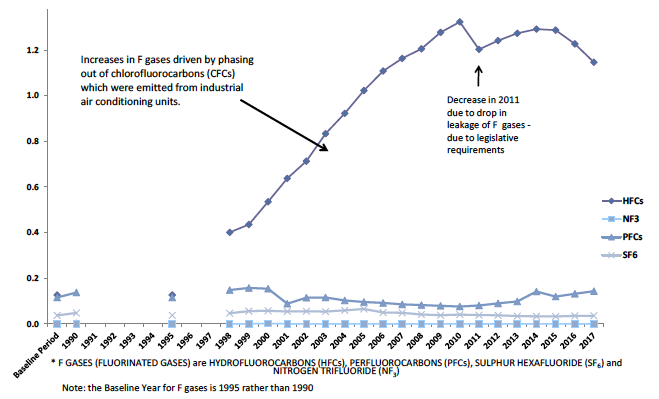
Main Points
- F gases are the most potent greenhouse gases with high global warming potentials but they are emitted in very small quantities. As a result, they contribute less to global warming than the other greenhouse gases in Scotland.
- There has been a sharp increase in F gas emissions from business and industrial processes between 1990 and 2017 (from 0.2 MtCO2e in 1990 to 1.3 MtCO2e in 2017). This is because F gases were introduced to replace chlorofluorocarbons (CFCs), which were used in appliances such as industrial air conditioning units. CFCs were banned under the Montreal Protocol, as they were contributing to the depletion of the ozone layer.
- F gas emissions in the residential sector result from the use of aerosols and asthma inhalers, and represent around 0.1 MtCO2e in 2017.
Contact
Email: andrew.mortimer@gov.scot
There is a problem
Thanks for your feedback